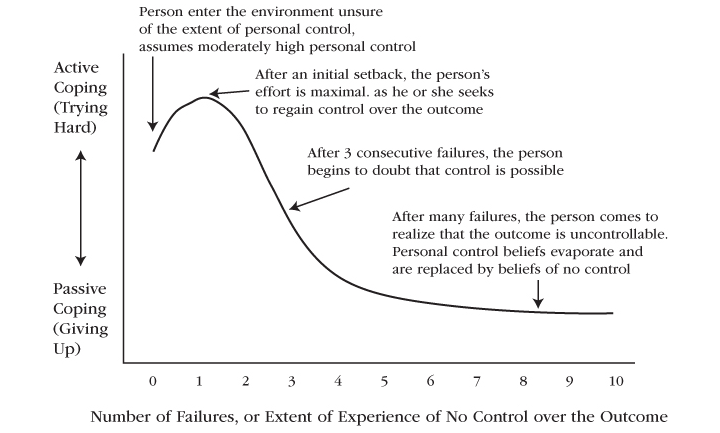Introduction
For this assignment, students of ENGL 301 were tasked to explain a technical term within our related discipline to readers who may not have previous knowledge on the particular subject, using three kinds of definition categories: parenthetical, sentence and expanded. The objective of this was to understand when there is a need and the importance for a definition and to consider on how much needs to be conveyed to different kinds of audience.
Term
Learned Helplessness
Situation
This is intended for new students to Psychology who may be interested to learn more about this field and become part of a lab that studies depression and related concepts.
What is Learned Helplessness?
Parenthetical Definition
Learned helplessness is an acquired reaction from the lack of control to an aversive stimulus.
Sentence Definition
Learned helplessness is a concept capturing the phenomenon when humans or animals will not act to avoid or escape aversion after feeling a lack of control to act or react to a negative situation.
Expanded Definition
Learned helplessness was a concept found in an experiment where harnessed dogs were confined in a box in which, no matter what action they took, they were administered electrical shocks. As a result, these sets of dogs did nothing to avoid the shocks. In contrast, dogs in the group that were able to jump to another side of the box that emitted no shocks immediately reacted to escape every time they were given a shock (as shown by an example picture below).

Figure 1: A dog in a shuttlebox escaping an electrical shock by jumping over to the side with no shock. Rose, S. M. (2019). Shuttle Box Dog Orange. Shuttle Box Dog Orange.png. Wikimedia Commons. Retrieved September 30, 2021, from https://commons.wikimedia.org/wiki/File:Shuttle_Box_Dog_Orange.png.
This concept of learned helplessness was subsequently found as a common phenomenon in many species from fishes to cats to humans with many different forms of aversive stimuli.
In particular, for humans, the learned helplessness was linked to the feeling of a lack of control over their situation, of the belief that nothing one could do would matter. For example, in a study by Hiroto & Seligman (1975), a group of college students were split into three groups where one group could stop a loud noise by pressing a button, one group that could not stop the noise and one that received no noise at all. Then they were asked to go into a “human shuttlebox” (a bigger version of the box shown in Figure 1 above) where they would be asked to turn a knob to shut off the loud noise completely. Those who could avoid the noise and those who received no noise were able to complete that task inside the “human shuttlebox” while those who could not escape the noise at the beginning failed to turn the knob. The same results were produced regardless of the aversive stimuli being presented (such as the study by Seligman & Maier (2016) where the inability to complete unsolvable puzzles would make the participants unable to escape) as they commonly were quoted to say after the study “nothing worked so why try?”.
It has been suggested that learned helplessness may be a cause of depression, presented through theories like the attributional theory of depression (Seligman 1975) and further clarified that this lack of control was based on what each individual would consider a situations “helpless” as learned helplessness was not shown in individuals that did not believe they had a lack of control over the situation. And because the individual feels that lack of control over their situation, Seligman (1975) theorized that when a person attributes failure through the lack of control to their own lack of ability, lowered self-esteem occurs and a cycle begins to form, producing a general expectancy of no control, even in other situations. This cycle propagates the idea of “helplessness” throughout an individual’s daily activities and events, which creates a depressive state. An example diagram that follows this line of theory can be seen in Figure 2 below:

Figure 2: Reactance and Learned Helplessness Model. Hugill, S. (2019). Reactance and Learned Helplessness Model. Reactance and Learned Helplessness Model.png. Wikimedia Commons. Retrieved September 30, 2021, from https://commons.wikimedia.org/wiki/File:Figure_3._Reactance_and_Learned_Helplessness_Model..png.
But regardless of the possible implications or theories of learned helplessness to depression, researchers have only proven that there is a relationship between concepts like learned helplessness and level of depression; it is still unclear if this kind of behaviour is involved in the cause or maintenance of depression, making it a point of interest to continue studying concepts like learned helplessness and their relationship to mental illnesses or other psychological factors.
References:
- Hiroto, D. S., & Seligman, M. E. (1975). Generality of learned helplessness in man. Journal of Personality and Social Psychology, 31(2), 311–327. https://doi.org/10.1037/h0076270
- Maier, S. F., & Seligman, M. E. (2016). Learned helplessness at Fifty: Insights from neuroscience. Psychological Review, 123(4), 349–367. https://doi.org/10.1037/rev0000033
- Seligman, M. E. P. (1975). Helplessness: On depression, development, and death. W H Freeman/Times Books/ Henry Holt & Co.
Leave a Reply